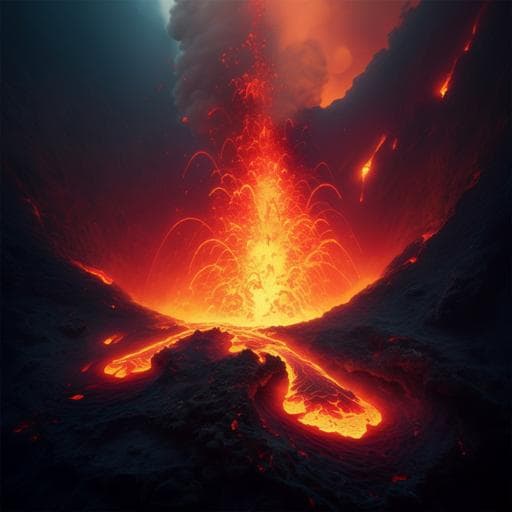
Earth Sciences
High temperature methane emissions from Large Igneous Provinces as contributors to late Permian mass extinctions
C. Chen, S. Qin, et al.
This groundbreaking research by Chengsheng Chen, Shengfei Qin, Yunpeng Wang, Greg Holland, Peter Wynn, Wanxu Zhong, and Zheng Zhou reveals that methane emissions from the Emeishan Large Igneous Province played a crucial role in global warming leading up to the end-Permian extinction. The study uncovers high methane formation temperatures and highlights significant environmental implications.
~3 min • Beginner • English
Introduction
Major mass extinction events over the last 500 million years coincide with eruptions of Large Igneous Provinces (LIPs), with associated magmatic activity and greenhouse gas release proposed as drivers. The Late Permian mass extinctions (LPME) comprise two events—the Guadalupian-Lopingian extinction (~260 Ma) and the end-Permian or Permian-Triassic extinction (~252 Ma)—which temporally align with the Emeishan LIP (ELIP) and the Siberian Traps LIP (STLIP), respectively. Stratigraphic and paleobiological records show strong correlations between LIPs, global carbon cycle disruptions (including 5–8‰ negative δ13C shifts), climate change, and biotic crises. While CO2 emissions from degassing, thermal metamorphism, and combustion of organic-rich strata have been emphasized, the timing and mechanisms of greenhouse gas release remain uncertain, and methane’s role has often been treated as secondary. Numerous occurrences of pyrobitumen in ELIP and STLIP regions imply widespread oil cracking to CH4. This study aims to directly assess the origin and formation temperatures of methane and evaluate the extent of oil-cracked CH4 generation linked to ELIP-induced heating and hydrothermal activity in the Sichuan Basin, and to quantify its potential climatic impact during the LPME.
Literature Review
Previous studies have linked LIPs to mass extinctions and carbon cycle perturbations, highlighting CO2 emissions from magmatism and contact metamorphism as primary drivers. Methane has been invoked from coal intrusions, clathrate destabilization, and microbial pathways but often considered secondary. Petrological evidence (pyrobitumen, gas-venting pipes) suggests that oil pyrolysis and carbon gas release occurred in both the Sichuan and Tunguska basins during the Late Permian, yet prior work relied largely on indirect indicators, lacked quantification of pyrolysis extent, and provided limited evidence for strong correlation with specific LIPs. The Sichuan Basin contains widespread pyrobitumen and dry natural gas within Sinian-Cambrian dolostones, implying in-situ oil cracking in geological history. High-resolution stratigraphy supports temporal links of ELIP and STLIP with the LPME, but the magnitude and precise contribution of CH4 from oil cracking to climate forcing remained uncertain.
Methodology
- Study area and sampling: 20 natural gas samples (dominantly CH4) were collected from Sinian Dengying (Z2dn) and Cambrian Longwangmiao (E1l) dolostone reservoirs in the Anyue gas field, central Sichuan Basin (outer zone of ELIP). Nine samples were analyzed for methane clumped isotopes and eleven for noble gas isotopes.
- Gas composition and stable isotopes: Bulk composition by GC-MS (Agilent 6890N). Carbon and hydrogen isotopes by GC-IRMS (Agilent 6890N–Isoprime 100; Thermo 1310–Delta V). Precision: ±0.2‰ for δ13C, ±2‰ for δD.
- Methane clumped isotopes: Δ13CH2D (and related isotopologues 12CH4, 13CH3D, 12CH2D2, 13CH2D2) measured by TILDAS (Aerodyne) at Lancaster University SFIGL with methane purification (Protium MS). Measurements referenced to a lab standard (LEC-1) after calibration; nominal cell pressure ~1.0 Torr. Δ13CH2D values converted to apparent formation temperatures.
- Noble gases: He, Ne, Ar abundances and isotopes measured on an Isotopx NGX mass spectrometer. 3He, 20Ne, 40Ar on Faraday; others on electron multiplier. Abundances normalized to air standards after blank correction; interferences (e.g., 40Ar++ on 20Ne) corrected during Ne analysis. He spike (HESJ standard) used for air normalization.
- Basin and kinetic modeling: Burial-thermal histories reconstructed for wells MX and GS using PetroMod 2016.2 with stratigraphy, tectonic events, and boundary conditions. Heat flow history and a geological heating rate of 5 °C/Ma applied. Hydrocarbon generation modeled using Tang (2011) SARA TI kinetics representing Type-I kerogen (dominant in Qiongzhusi Fm.). Modeled reservoir temperatures compared to measured values and clumped isotope-derived temperatures.
- Methane generation and emission estimation: A methane emission model relates oil-cracked methane to pyrobitumen yield using an experimentally derived conversion ratio R = 1.09 L CH4 per g pyrobitumen at high maturities. Gas generation intensity (GGI) computed as GGI = H × C × D × R × 10^7 (m3/km2), where H is reservoir thickness (m), C pyrobitumen content (wt%), D rock density (g/cm3). Total methane generation (TMG) = GGI × area (A). Total methane emission (TME) = TMG – total gas reserves (TGR). Parameters and calculations summarized in Supplementary Table 5.
Key Findings
- Gas characteristics: Gases are extremely dry with C1/ΣC2–5 = 583–3019, CH4 = 90.11–99.87%, C2–5 = 0.03–0.17%, CO2 up to 8.36%, H2S up to 1.51%, N2 to −3.23% (presence of analytical conventions); methane δ13C = −32.2‰ to −34.2‰, δD = −134‰ to −147‰; ethane δ13C = −27.5‰ to −33.3‰. Isotope fields indicate equilibrium thermogenic origin with negligible biogenic or abiotic influence.
- Clumped isotope temperatures: Δ13CH2D-derived methane formation temperatures are 246–250 °C (E1l; average 249−17/+19 °C) and 248–269 °C (Z2dn; average 256−20/+22 °C), significantly exceeding present reservoir temperatures (140–165 °C), TSR peak (~140 °C), oil-cracking peaks (160–180 °C), and modeled maximum burial temperatures (200–220 °C). Temperatures align with highest trapping temperatures (249–319 °C) of quartz inclusions associated with ELIP-related hydrothermal fluids, implying abnormal hydrothermal heating.
- Compositional/kinetic consistency: Kinetic modeling indicates that generating gases with such extreme dryness requires formation temperatures >250 °C at geological heating rates of ~5 °C/Ma; maximum burial temperatures (<220 °C) would have produced wet gases, contradicting observations.
- Petrological evidence: Pyrobitumen displays mesophase pitch-like textures and honeycomb microporosity indicative of high-temperature, rapid “coking” by hydrothermal invasion rather than slow burial heating.
- Noble gas evidence for mantle input: He isotopes show R/Ra of 0.0115–0.0256 in E1l (crustal), 0.300–0.418 (Z2dn-G2; mantle contribution ~4.8–6.7%), and 1.37–2.36 (Z2dn-G1; mantle contribution ~22.4–38.5%), indicating isolated mantle-derived hotspots linked to ELIP. 40Ar/36Ar values deviate from atmospheric; 40Ar*/4He ranges imply contributions from hotter/deeper crust and variable mantle input, with fractionation consistent with high-temperature release and heterogeneous hydrothermal activity.
- Temperature constraints from noble gases: 40Ar*/3He ratios in Cambrian reservoirs imply maximum temperatures >250 °C, consistent with clumped isotope temperatures.
- Methane generation/emission magnitudes: Anyue region total methane generation by oil cracking up to 2.01 × 10^14 m3; after subtracting preserved reserves, total methane emission ~2.00 × 10^14 m3 (~144 Gt; >99% released). Basin-wide scaling by pyrobitumen abundance suggests Sichuan Basin emissions of ~1440 Gt CH4, equivalent in 100-year GWP to ≥40,410 Gt CO2 (GWP100 ~28), more than twice estimated ELIP CO2 emissions and >1000× current annual anthropogenic CO2 emissions (36 Gt in 2019).
- Timing and implications: ELIP-related hydrothermal activity (~259 Ma) likely peaked within 1–5 Ma, temporally overlapping with the GLE (~260 Ma). High-temperature CH4 emissions could have initiated significant global warming prior to, and potentially independent of, massive CO2 outgassing. Analogously, STLIP could have generated even larger CH4 quantities due to greater magma volumes and widespread organic-rich sediments.
Discussion
The combined clumped methane isotope, noble gas, kinetic, and basin modeling evidence demonstrates that methane in the Anyue gas field formed at temperatures well above those attainable by burial alone and is instead linked to ELIP-related hydrothermal heating and mantle-derived fluids. The extremely dry gas compositions and Δ13CH2D-derived temperatures (>246–269 °C), together with noble gas signatures showing significant mantle He contributions in Sinian reservoirs, support a scenario where ELIP-induced hydrothermal fluids rapidly cracked pre-existing oil pools to methane and generated pyrobitumen. This process created overpressured reservoirs and provided conduits (faults, hydrothermal channels) for rapid methane release to the paleo-atmosphere. The estimated methane emissions—144 Gt for the Anyue region and ~1440 Gt for the Sichuan Basin—are climatically consequential, equating to ≥40,410 Gt CO2 in 100-year warming potential. Such emissions could have driven rapid global warming associated with the Guadalupian-Lopingian extinction and potentially contributed to the end-Permian crisis, especially considering that CH4 generation thresholds (<300 °C) may be reached before large-scale CO2 degassing from basaltic eruptions. The findings imply that high-temperature, oil-cracked methane associated with LIPs is a significant, previously underappreciated driver of paleoenvironmental change and mass extinctions. Comparable mechanisms likely operated during STLIP and other LIPs (e.g., CAMP), aligning with independent evidence for large thermogenic carbon releases during these events.
Conclusion
This study provides direct geochemical and thermometric evidence that ELIP-related hydrothermal activity generated high-temperature methane via rapid oil cracking in the Sichuan Basin. Methane clumped isotope temperatures, noble gas mantle signatures, gas compositions, and kinetic/basin models collectively indicate that ELIP acted as a widespread coking furnace, producing extremely dry thermogenic methane and substantial pyrobitumen. Quantitative estimates suggest CH4 emissions on the order of 1440 Gt for the Sichuan Basin, with strong implications for greenhouse forcing and the Late Permian mass extinctions. The work reframes the role of methane in LIP-driven crises, highlighting that CH4 emissions may precede and amplify CO2-driven warming. Future research should map the global distribution and abundance of reservoir pyrobitumen across LIPs, refine regional and global methane emission budgets from oil cracking, integrate climate-chemistry feedbacks (e.g., ozone depletion) into impact assessments, and extend clumped isotope and noble gas diagnostics to other LIP provinces and stratigraphic settings to better constrain timing, magnitude, and pathways of methane release.
Limitations
- Sampling is confined to the Anyue gas field within the outer zone of the ELIP; spatial extrapolation to the entire basin and other LIPs introduces uncertainty due to geological heterogeneity.
- Methane emission estimates rely on pyrobitumen-based conversion factors, reservoir property assumptions (thickness, density, content), and are sensitive to area scaling and preservation (TGR) uncertainties.
- Climate implications are discussed without incorporating feedback processes (e.g., stratospheric chemistry, radiative interactions), and thus warming potentials are GWP-based approximations.
- Noble gas interpretations indicate heterogeneous hydrothermal processes and possible He–Ar fractionation, adding uncertainty to precise mantle-crust mixing proportions.
- Temporal resolution for peak heating and gas release is constrained indirectly (fluid inclusions, modeling), not by continuous high-precision geochronology tied to gas generation episodes.
Related Publications
Explore these studies to deepen your understanding of the subject.







